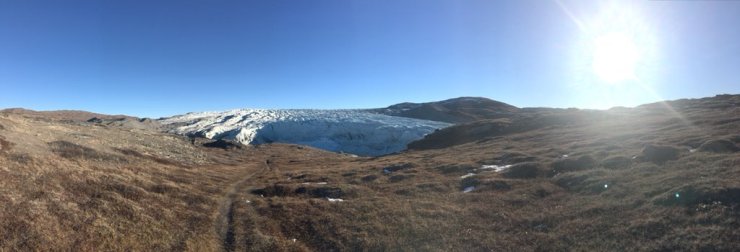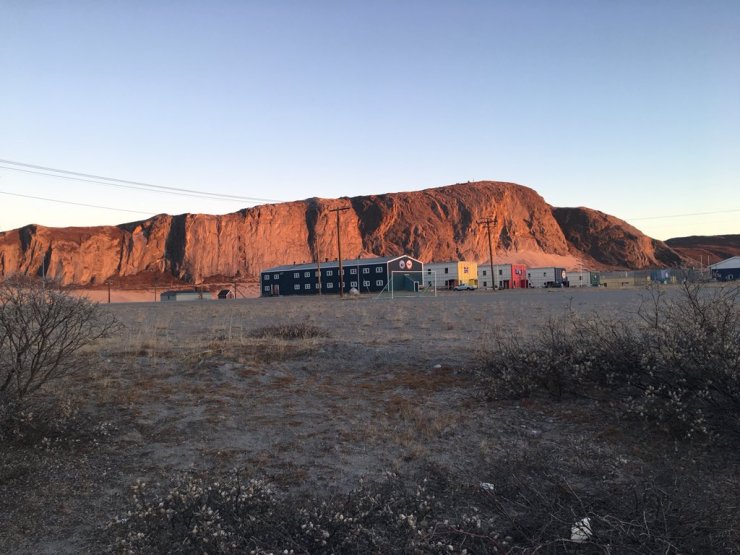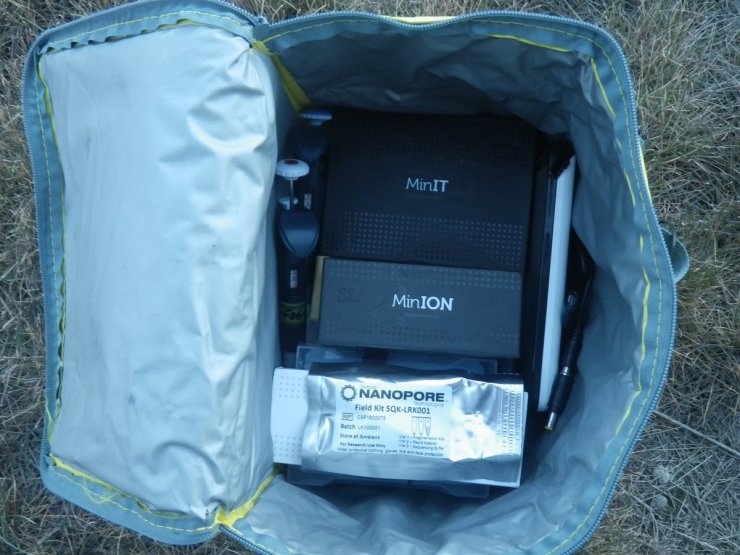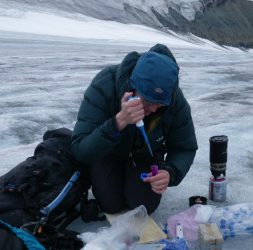
Tl;dr: The Russell Glacier outlet of the Greenland Ice Sheet. Some 200,000 square kilometres of ice within the Russell catchment drain to here. Vast, and the most important contributor to sea level rise, working 30km inland of this point in winter means sequencing DNA in an environment that teeters daily between sublime and violent.
As I write this I am thawing out in Copenhagen after participating in an expedition on the Greenland Ice Sheet. This is the fifth time I’ve worked on the Ice Sheet, but the trip had a major twist. We would be working outside of the melt season. This meant camping in temperatures of -10ºC to -30ºC and potential for even hurricane force winds coalescing to create significant windchill and risk of frostbite. Our task necessitated working in these conditions: One simply does not go exploring inside drainage shafts in ice sheets while they are actively carrying meltwater. It would make for a very short inquest.
While the overall story, results and images from the ice camp are under embargo, so beautiful aurora and tales of folk crawling from tents trashed in hurricane-force storms will have to wait.
Here I’ll write about some of the technical considerations and challenges encountered.
Working with PhD students Melanie Hay and Aliyah Debbonaire and science leader Joseph Cook, my goal was to lead the characterization of microbial communities sampled on the trip, using nanopore DNA sequencing. Of course, we’ve done this kind of thing before, including in field camps on Greenland as part of the Ice Alive filming. Neverthless, transferring our experience to sub-zero conditions in very remote, on-ice camp would present some challenges. Ewan Birney recently wrote that analysing genomes is routine in the way that the US Navy routinely lands planes on aircraft carriers. Highly trained people with the right kit make it achieveable, but it is not easy.
Now try landing the plane in a whiteout, without reliable power, in temperatures as cold as your freezer at home.
So, in preparing for this project I identified three main obstacles:
1. The cold.
I had to anticipate temperatures as extreme as -30°C. This poses two specific problems.
Regular laptops do not like such temperatures. Nanopore-specification computers are not cheap enough to be considered disposable. While there are ruggedized laptops, the high spec required to run a MinION (1 TB SSD, i7, >16GB RAM etc) lies in what I thought was a non overlapping part of the Venn diagram. Fortunately, with the help of Gwen and Simon from Aberystwyth University’s Information Services department, we found and procured a mil-spec, ONT spec laptop. Capable of functioning at -29°C and storage at -50°C, running Windows 10 with its linux subsystem this laptop would drive our MinION and be our on-ice bioinformatics platform (running albacore, canu, porechop, sintax, kaiju, centrifuge, prokka and others). I’m typing this blog post on it now, and it did its day job really well.
Critically, MinION flow cells cannot be allowed to freeze. To do so lyses the membranes holding the nanopores. This is why they must be stored at +2-8°C. From experience with ambient-shipped flow cells I knew there’s some tolerance at the upper end, but it would be game over should the flow cells drop just a few degrees beneath their storage envelope. After weeks of trials with ever thicker styrofoam boxes and chemical warmers for shipping tropical fish in our -25ºC cold lab at Aberystwyth I remained dissatisfied. The exothermic iron oxidation reaction in the warmers provides steady ~38ºC warmth for 72 hours in normal conditions. However, as temperatures nearby reach freezing, the chemical reaction fizzles out. This means there is a cascading failure mode to the system which can only be overcome by piling in too many heat packs which would cook the flow cells. So, taking inspiration from the Sourdough prospectors, we went low-tech.
The only sustainable source of uninterrupted warmth for storing these flow cells on a subzero expeditionary project turns out to be humans. When wearing down insulation gear, there is a gradient from skin temperature to freezing or below. So, in the chest pocket of a Buffalo smock I carried a mini Peli case with five nanopore flow cells, monitored by a temperature logger run via bluetooth from a smartphone. This typically afforded temperatures +8-16ºC in the day time when covered by a down jacket. For comfort at night I would store the box loose inside an expedition sleeping bag. After half-hourly checks of temperature the first night in camp, I found I could store the flow cells confidently at +16-22ºC, warm enough to survive the occasional filling of the pee bottle in night time temperatures of -15ºC and likely colder. Although uncomfortable and unseemly (not ideal for a photoshoot for a major fashion company…) this system worked well, as I had a vested interest in staying warm and fed. The only time low temperature alarms were triggered were on the final morning while digging the camp out in severe windchill. By then it was time to get on the helicopter and much of the project was in the bag.
MinION runs themselves did not suffer unduly from the cold. Placing the MinION on a thawed cold pack with one heat pad inside a small NEB styrofoam box maintained 20°C nicely as an ambient temperature, while the ASIC had no trouble holding a steady 34.0°C.
Furthermore, freezing temperatures did not affect any of the lab procedures. We used PowerSoil kits as described in our preprint, thawing reagents with warm water. We also used the freeze-dried field sequencing kit gifted us by Oxford Nanopore, but I’m confident that ligation sequencing kits would have worked well too. After all, we all store all the kits and enzymes at -20ºC normally – and simply gentle thawing with warm water or hands would suffice.
Sadly, the one bit of kit which did not work was our miniPCR cycler. It detected the ambient temperature was too low, and decided not to play. This is a shame as it’s an otherwise useful bit of kit. So, we resorted to low tech again. Holding transposase to achieve room temperature, and then killing it with hot water in an insulated mug made for good libraries.
Metagenomic library prep using freeze-dried consumables.
2. Mains power
Power in camp would be provided by two 1kw generators. The supply of fuel, and as it turned out, their reliability, meant we could not operate on mains power throughout. For DNA extraction this meant we used a terralyzer and a dremelfuge as contingencies should the generators fail.
While our laptop was good for 6-8h battery time running a MinION in -25ºC conditions, we sought a contingency which could permit sequencing with real-time basecalling from battery power. We’re very grateful to the team at Oxford Nanopore Technologies for providing access to the MinIT, which uses a GPU to support fast basecalling. Our MinIT arrived at the last minute before departure but performed really well.

Kangerlussuaq: Even a former Cold War bomber base can look nice in the evening sunlight.
Initiating Rolex Laureate Joseph Cook into the nanoporati back in the “Kanger Centre” (a kitchen table in Kangerlussuaq) after our return to using both MinIT and freeze dried library preps was fun. Joe has just been listed on San Miguel’s Rich List of people rich in life experiences – surely metagenomics in a hostel must be up there…
3. Logistical fail
At the heart of it, using a MinIT, MinION, iPhone, Dremelfuge, Terralyzer, PowerAdd battery and lyophilized library prep kits it’s possible to do DNA extraction and sequencing with battery-powered kit that fits in a handbag (a MinBAG? Sorry – it’s been a long week…). Counting just the gear needed for sequencing, this weighs 2.2 kg.

Is a MinBAG a thing?
But possible does not mean sensible or sustainable. To achieve this project, Melanie and I have travelled with >100 kg of gear on a variety of trains, planes and helicopters.This joined well over 700 kg of gear required to sustain eleven people on the Greenland Ice Sheet for two weeks.
Of course our haul includes things like ice corers and sleeping bags and wetwipes, but packing up the equipment, consumables, computers and camping gear chosen for the job in the first week of the academic year is not to be undertaken lightly. This became apparent two ways.
Rock > Paper > Scissors > Cello > Ice corer. Firstly, no sooner than we were at the departure gate for our flight from Birmingham, it transpired that a good few of the other seats on our small plane were occupied by an orchestra. We could see tuba, cello, xylophone being loaded but the bags of all passengers without a connecting flight were dumped on the tarmac. We left for Greenland with only hand luggage and dented faith in the airline. Fortunately, our lab gear and most of our field clothing arrived in Greenland in the gap day scheduled between arrival and insertion. However, my cold weather boots did not. They were scheduled to arrive at 1005 local while we were due to be inserted by helicopter from 0940 local.
With only a pair of gaitered summer mountaineering boots to wear and one pair of hiking socks I could stand to lose a toe or two. Personally, that is a price I might be prepared to pay in the line of duty, but prior occurrence of frostbite counts very badly in polar medical clearance exams. To deploy could be career ending.
Air Greenland worked a quiet miracle to hold the helicopter back and get the bag. They get the bag containing these boots to the helicopter flightline within fourteen minutes of the Airbus reaching the terminal. My toes and I are grateful.
This served as a good reminder that no matter how carefully planned a trip is, with overnight layovers between flights and contingency gap days, factors beyond your control can still mess up the logistics. A field project can be doomed to fail before it’s even left.
The other logistical slip up was well within my responsibility. Before departure, I had ordered a fresh Qubit DNA quantification kit. Fluorometric quantification using Qubit is the easiest way of verifying DNA extraction, and that you have acceptable yields in ligation sequencing prep steps after bead cleanups. On my checklist of 164 items to be packed and transported for this project, it was listed as “Qubit hsDNA kit”. Unfortunately, different storage conditions and the inclusion of SYBRSafe (a similar orange-DMSO dissolved stain in an identical tube) in the kit list meant I did not spot the Quant-it reagent was missing. This became apparent at the end of the first batch of DNA extractions.
We worked the problem – substituting Quant-it with the SYBRSafe, visualizing the assay cocktails on the BlueGel – to no avail. In the end I decided to sacrifice the flow cell with the lowest number of active pores, a five month veteran with <600 active pores brought as pore fodder, to estimate the DNA concentration. From the low occupancy it was clear we could do with concentrating the DNA, so the following morning we did – with wonderful results. Attention to detail is essential, but with many competing cognitive demands before deploying, cross-checking inventories is vital. In future I should inventory at the component level for any item which is from an opened packet.
So, in summary: While it is possible to fit everything you need for in-field DNA sequencing into a £7.99 insulated cool bag from Tesco with room to spare, doing so reliably in remote environments requires considerable preparation and contingency.
Acknowledgements: We are grateful to the support provided by Zoe, Rich and Rosemary at ONT, our primary sponsors Moncler, and Aberystwyth University’s Interdisciplinary Centre for Environmental Microbiology’s “MoulinEx” grant. I thank expedition leader Francesco Sauro and his Miles Beyond exploring team; Joseph Cook at the University of Sheffield; Melanie Hay, Aliyah Debbonaire, Alun Hubbard, Ian Keirle and Mike Rose at Aberystwyth University.





